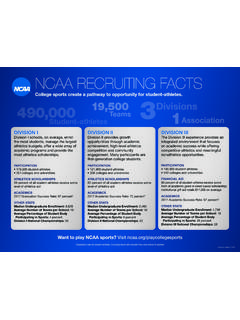Transcription of SPRINT TRAINING Coach Steve S. Silvey Assistant Track ...
1 SPRINT TRAINING . Coach Steve S. Silvey Assistant Track & Field Coach The University Of Oregon Many coaches believe that athletes are born God-given' SPEED and nothing can be done to change it. As a Coach with over twenty years of experience at the high school, junior college and university levels, I disagree with this statement. To the contrary, I have found anything is possible with an athlete who has above average talent and who is willing to, Train hard Focus on the right things - doing all of the little things before the workout such as, correct warm-up and cool-down procedures, proper daily nutrition and hydration, apply good sleeping habits and additional flexibility work.
2 One example of this theory is the 100 Meter World Record Holder, Tim Montgomery ( ). In the Spring of 1993, I met and persuaded Tim to sign a scholarship to run for the junior college program at Blinn Junior College in Brenham,Texas. At the time Tim was a very thin high school sprinter from Gafney, South Carolina. As a high school senior, with a mere (electronic timed) 100 meter best of (FAT), Montgomery, was not ranked as one of the nation's Top 25 High School Sprinters'. His high school Track team was so small they did not have four guys to make up a 400 meter relay team, so Tim did not have the opportunity to participate in a 400.
3 Meter relay team or learn the skills involved in that event. When Montgomery arrived at Blinn College in the fall of 1993 he was 5'-10 tall and weighed 128 pounds. He definitely did not fit the definition of a typical high school sprinter or typically what we look for when we recruit. What Montgomery did have was a great family support mechanism and a super attitude. Montgomery came to Brenham, Texas with the hunger to be the best he could be. Along with his positive attitude, he brought with him great daily work habits. Tim had the right attitude, he trained hard and focused on the right things.
4 First, he focused and trained to improve his overall body strength, basic flexibility, and running technique thru many hours of dynamic flexibility drills, hurdle-rhythm drills and speed drills and the results began to show. Early in the spring of 1994, at the Sun Angel Classic at Arizona State University, Tim Montgomery ran an outstanding lead-off leg on our 800 meter relay. That time beat a number of collegiate powers such as , and A. and several world class Track clubs. Later that same spring in May at the National Junior College Track Championships in Odessa, Texas, Montgomery bested Nigerian World Class Sprinter, Daniel Effiong for the 100 meter championship with a time of seconds.
5 At the time Montgomery's time was thought to be a new World Junior Record. The existing record was seconds and had been set by a former athlete of mine, Andre Cason, who I recruited when I was at Texas A&M University in 1987. Cason, like Montgomery, was another example of an athlete who in the beginning did not fit the sprinter mold . At the time one of my fellow Assistant coaches felt that at 5'5 Cason was too short to ever become an elite sprinter and questioned my recruiting him. Cason, like Montgomery, defied the odds as he later became an NCAA 60.
6 Meter indoor Champion and the Silver medalist in the 100 meters at the 1993 World Championships with a time of Unfortunately, (governing body of Track ) rules nullified Montgomery's achievement later that month. The world record procedure requires that the Track must be measured with a steel tape'. Later in May when the Track was measured, it showed that the Track in Radcliff Stadium in Odessa, Texas was 2 inches short thus nullifying Montgomery's world junior record. Logically however, if we added .01 or .02 to Montgomery time to account for the 2 inches the Track was short Tim's time would have been vastly superior to the previous world junior record of However, not all things are as easy as they should be and the the governing body of Track and field ruling stood.
7 Later, Track & Field News officially converted Tim's mark to seconds. Regardless of the ruling, since that day in May to this, I always refer to Tim as SLIM FAST ! At 5'10 this128 pound athlete proved that you don't have to be a big, thick, muscle-bound athlete bench pressing 300 pounds to run fast SPRINT times. As I Coach , I have been blessed to have been able to recruit good athletes like Tim and Andre who were willing to work hard on and off the Track to become elite athletes. Presently I have recruited and/or coached, 9 8 athletes who have run under seconds for the 100 meters 9 6 athletes who have run under for the 200 meters 9 5 athletes that have run under for the 400 meters In addition, I have also coached relay teams that have run: 400 Meter Relay 800 Meter Relay 1 1600 Meter Relay 3 SPRINT Medley Relay 3 But speed isn't just for Track anymore how many of you feel SPEED is a very important ingredient to the success of your sport?
8 If you agree it's important, what are you doing on a regular basis to prepare your athletes to become faster? When it comes to an athlete's SPEED, I believe it starts from the ground up. First, for the athlete to excel in speed Development, he or she must first learn to use Dorsi-Flexion with the foot. Most young athletes use Plantar Flexion . Plantar Flexion is BAD, because this downward pointing of the toe causes a breaking effect upon contact with the ground. This is similar to putting on the brakes in a moving car. Plantar Flexion keeps the athlete's foot on the ground maximizing ground time which translates into slower SPRINT performances.
9 This braking effect also puts a lot of strain on the ankle, shin, and, most of all, the hamstring muscles. I. believe Plantar Flexion is the number one cause for athletes getting SHIN SPLINTS . Dorsi-Flexion is keeping the toe and heel up while running. The runner is literally stretching the calf muscle while running. When running, the athlete pulls the heel through to the buttocks . and then places it on the ground under the knee. When the athlete's foot lands on the Track surface or ground, the foot is then cycled backwards or pulled up to the buttocks.
10 At this point the foot is then brought back down to the ground with again the (toe up) as it makes contact with the ground underneath the knee. A common mistake made by coaches is telling their athletes to take longer strides'. Over-striding causes a breaking effect as the athlete often lands on his heel. The athlete also will lose power. How does the use of Dorsi-Flexion make an athlete faster and why is it better than Plantar Flexion? Dorsi-Flexion makes the athlete much more active upon contact with the Track and also allows the athlete to get-off the Track surface quicker.




